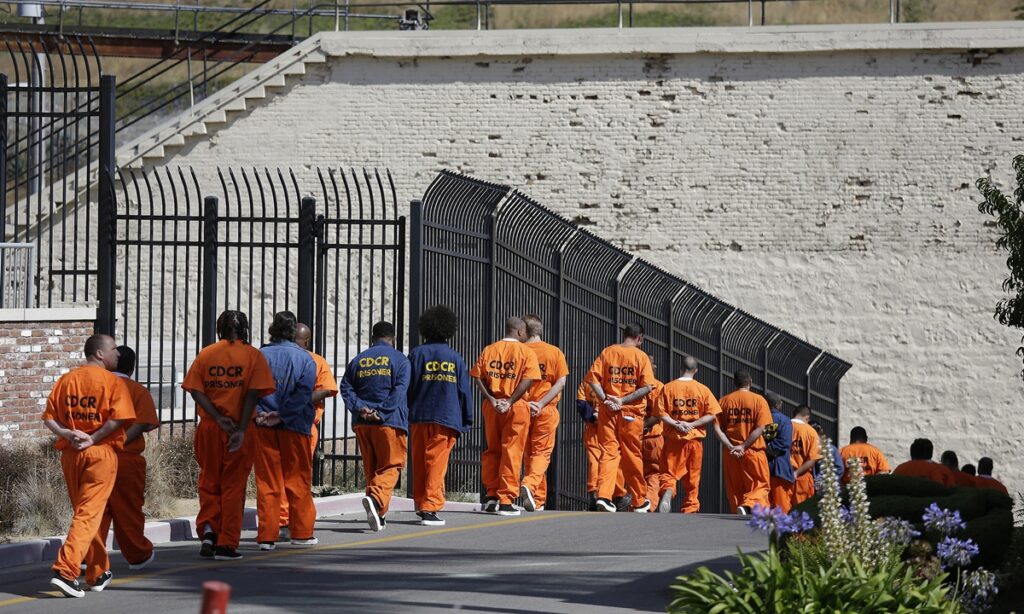Editor’s Note:
Inmates in prisons are subject to labor exploitation, minors working as child laborers are abused, human trafficking remains rampant: Today, more than 150 years after the abolition of slavery in the US, the above-mentioned problems still exist in the country. Some American politicians have racked their brains to fabricate the “sad narrative” of “forced labor” in China’s Xinjiang region, but a lie repeated a thousand times is still a lie. It is the US, a self-claimed “human rights defender” or a “beacon of freedom,” that should be accused of using forced labor, which plainly demonstrates the US’ real disregard for basic human rights and their brutal exploitation of the country’s workforce.
The Global Times is publishing a series of stories that will uncover the four “crimes” of the US, a real “contemporary slavery empire.” The following is the first installment of the series: Prisons, the darkest corner of the US, where countless inmates suffer from exploitation.
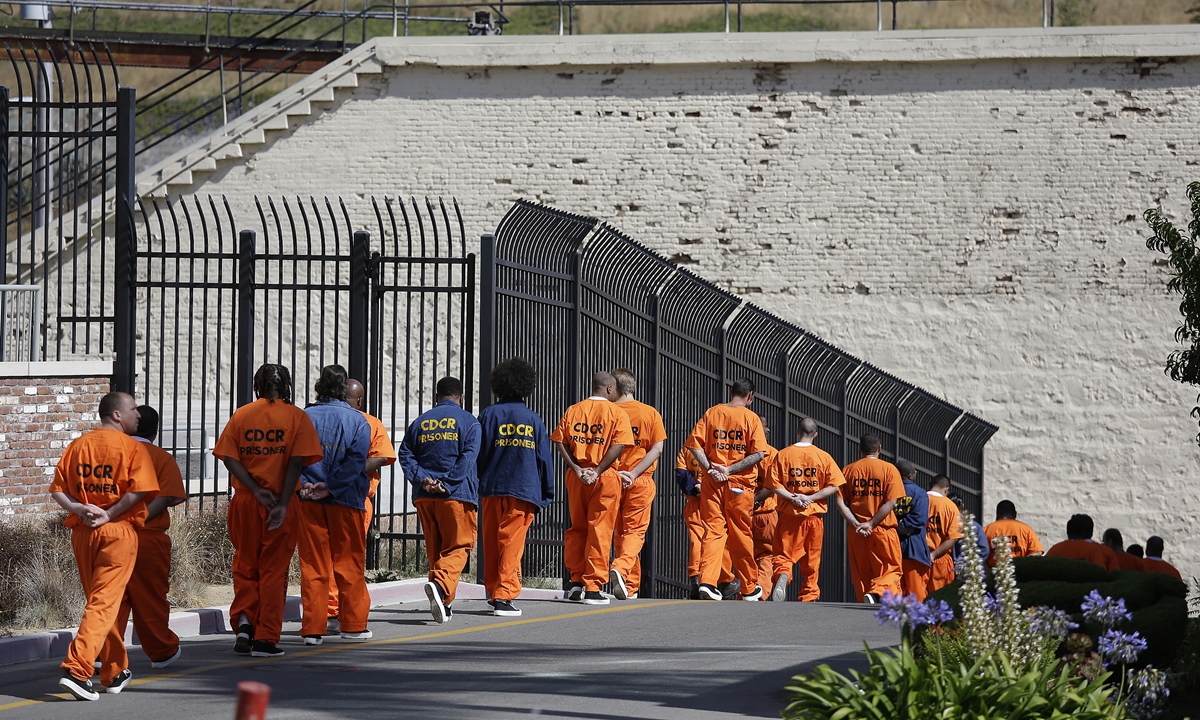
Inmates walk in a line at San Quentin State Prison in California on August 16, 2016. Photo: VCG
Prisons in the US are not just facilities to detain criminals, but also segments of the capitalist chain dedicated to making profits. In these veritable camps prisoners are squeezed to their limit to provide near-to-free labor, while the US has been groundlessly accusing other countries around the world of imposing “forced labor.”
A social problem deeply rooted in the country since the American Civil War, forced labor of incarcerated people in the US has become an open secret nowadays, as prisons serve as huge profit-making businesses, while the operators behind them maintain close political affiliations.
A recent report published by the University of Chicago suggested that two-thirds of the inmates in the US have to work, and three-quarters of them admitted during a survey that if they denied to work, they might face punishment.
Moreover, prison laborers create billions of dollars’ worth of goods and services each year but only get paid a few pennies per hour, without being given proper training or opportunities to develop skills for their post-release careers.
“The labor conditions of incarcerated workers in many US prisons violate the most fundamental human rights to life and dignity,” Clinical Professor Claudia Flores from University of Chicago Law School noted.
For some time, some anti-China forces led by the US have made up the so-called concept of “large-scale forced labor” in China’s Xinjiang region and they used this as an excuse to abuse long-arm jurisdiction and export control measures to hurt China’s businesses.
“These forces can easily make up stories about ‘forced labor camps’ without needing any investigation, because they can just see and relate the US’ own experience and give it another name,” analysts said. They noted that the US, which has always preferred to act as a “human rights preacher,” has been operating “dark prisons” all the time, where inmates are tortured and abused. Actually, these prisons are a typical example of the US’ violations of human rights.
‘A dollar a day’
In the US, roughly 800,000 people incarcerated in prisons are working behind bars. When they refuse to work, the inmates may face punishments such as “solitary confinement, denial of sentence reduction or loss of family visitation rights,” said the comprehensive nationwide report that the University of Chicago Law School’s Global Human Rights Clinic and the American Civil Liberties Union released on June 16.
The report indicated that prison laborers are “at the mercy of their employers.” They have no control over their work assignments, do not receive a minimum wage or overtime protection and are not allowed to unionize.
Moreover, the prison laborers do not receive adequate training and equipment and “are denied workplace safety guarantees, despite often operating in dangerous working conditions.”
Therefore, 64 percent of the prison workers surveyed said they were worried about their safety at work, 70 percent said they hadn’t received any formal job training and 70 percent said wages did not cover basic living expenses such as soap and communications.
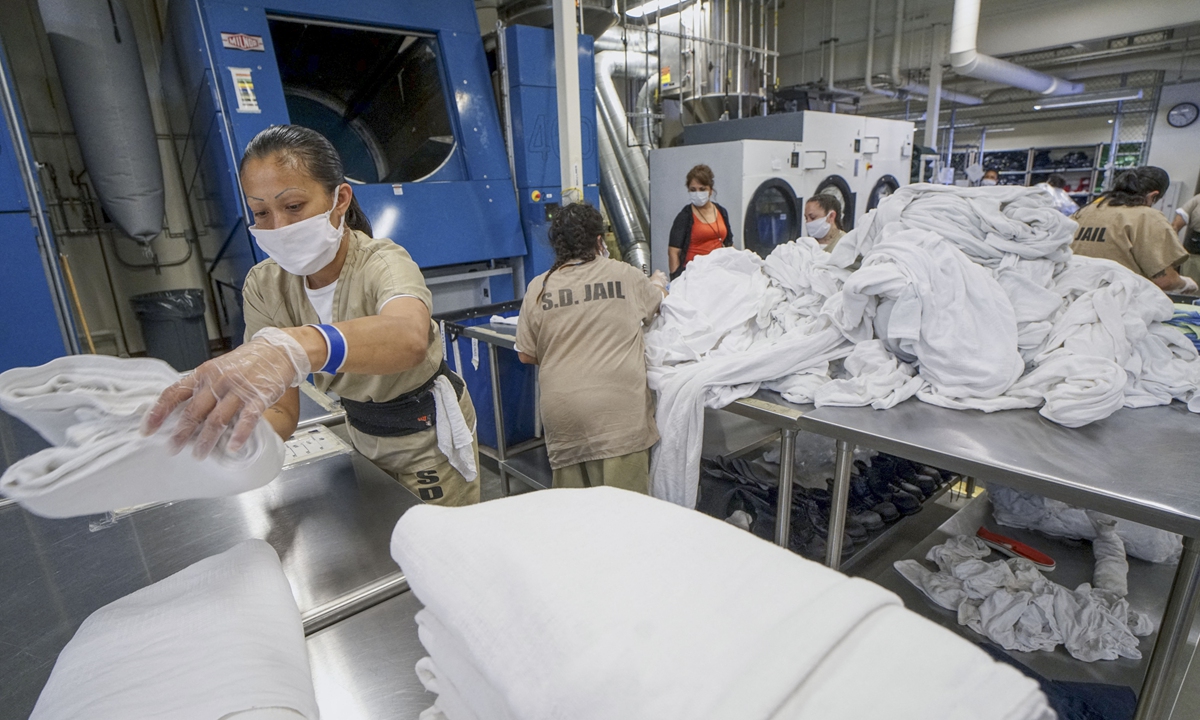
Inmates work in the laundry room at Las Colinas Women’s Detention Facility in California on April 22, 2020. Photo: AFP
By comparison, prison labor produces at least $2 billion worth of goods and $9 billion in prison maintenance services each year, and those numbers may actually be higher.
The report states that most US states pay only pennies an hour for prison labor, while Alabama, Arkansas, Florida, Georgia, Mississippi, South Carolina, and Texas do not provide any wages at all. In the other states, the average wage for non-industrial work is 15 cents to 52 cents an hour, however, up to 80 percent of prison laborers wages are withheld for taxes, room and board and court costs.
According to the Federal Bureau of Prison, as of 2021, inmates in federal prisons earn between $0.23 and $1.15 an hour. However, the federal minimum wage for covered nonexempt employees is $7.25 per hour, according to the US Department of Labor.
Some of the products are for the US federal government. For instance, more than 50 percent of Federal Prison Industries (FPI)’ sales come from the Department of Defense. The FPI is a wholly owned government corporation that was established by the US Congress.
“The United States has a long, problematic history of using incarcerated workers as a source of cheap labor and to subsidize the costs of our bloated prison system,” says Jennifer Turner, principal human rights researcher with the American Civil Liberties Union’s Human Rights Program, according to media reports.
As of July 2021, the US had the highest number of incarcerated individuals worldwide, with almost 2.1 million people in prison, according to the Statista. The US has 1,833 state prisons, 110 federal prisons, 1,772 juvenile correctional facilities, 3,134 local jails, 218 immigration detention facilities, and 80 Indian Country jails as well as in military prisons, civil commitment centers, state psychiatric hospitals, and prisons in US territories, according to a 2020 report on the Prison Policy Initiative website, quoting official statistics.
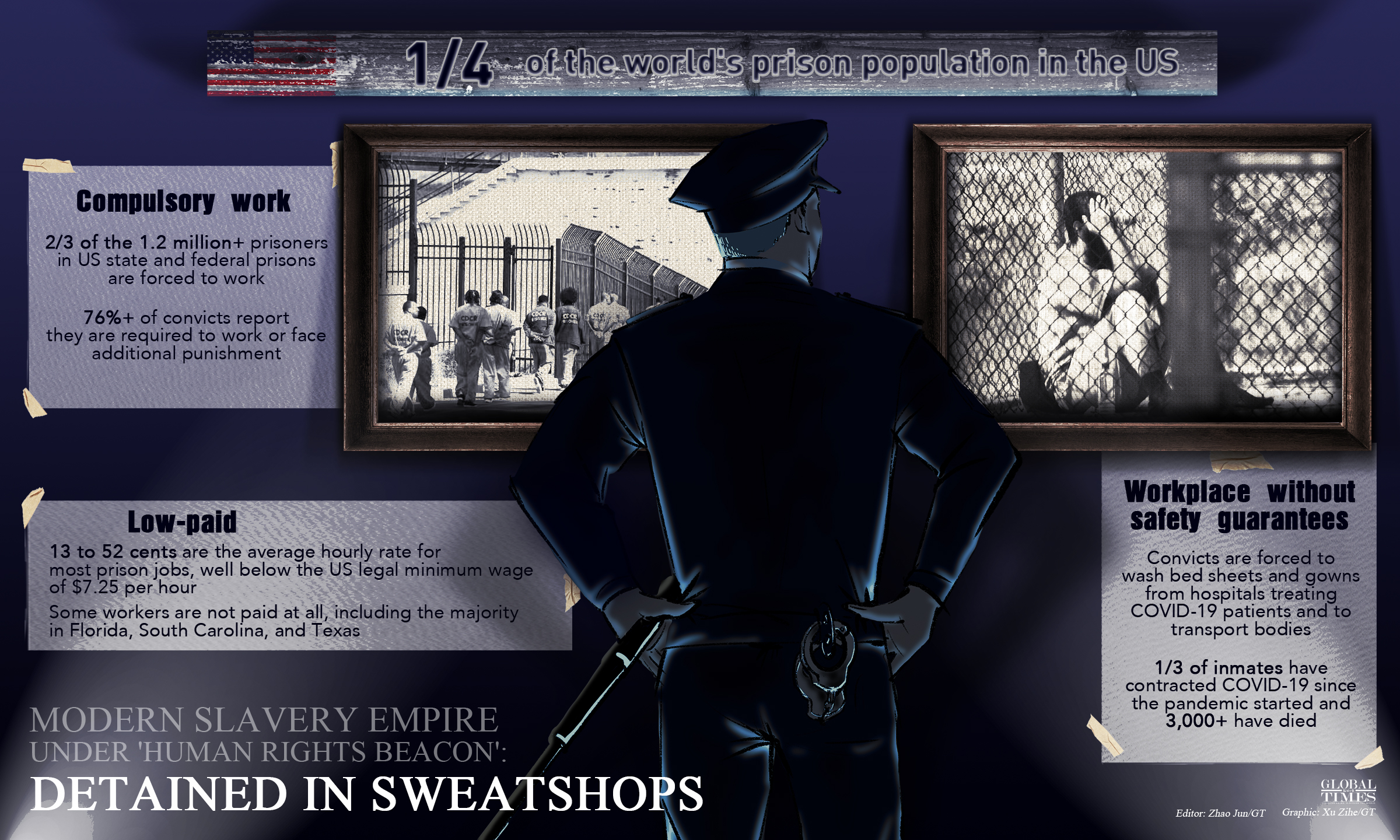
Graphic: Xu Zihe/GT
Long-lasting ‘legal’ slavery system in jails
Forced labor in prisons has been legal in the US for over a century.
Although the 13th Amendment to the United States Constitution, passed by the Congress on January 31, 1865, aimed to abolish slavery, it actually allowed slavery to remain legal.
The famous amendment, “Neither slavery nor involuntary servitude, except as a punishment for crime whereof the party shall have been duly convicted, shall exist within the United States, or any place subject to their jurisdiction,” makes slavery a “means of punishment,” allowing the government to legally impose forced labor on incarcerated people across the country.
Today, the consequence of the legal slavery system of jails still haunts the country deeply, becoming the nightmare of countless inmates, who cannot do much to change their own situation.
A Los Angeles Times report published in October 2020 unveiled that during the COVID-19 outbreaks, factories in California prisons were still running, while inmates worked for pennies an hour as the virus spread.
In a women’s prison in California, some inmates had to stitch facial masks 12 hours a day, but themselves were not allowed to wear the masks. The women were worried as the clothing they used to make masks came from a nearby prison, where the COVID-19 outbreak had already killed 23 inmates at that time.
In July 2020, some prisoners said that “they are being used as slave labor” by the Colorado prison system, and filed a lawsuit against the local government, the state prison system and a private prison operator, the CBS Denver reported.
“I had a kitchen job which was like going to hell every day”, said Adelbert “Jack” Bassford, who was admitted to a Colorado prison, where he was paid 10 cents per hour to sweep kitchen floors.
Moreover, prison laborers have been forced to risk their lives just for a chance to wipe their criminal records.
In California, thousands of incarcerated men, women and juveniles join one of the 192 inmate fire brigades every year, working 24-hour shifts and being paid as little as $2.90 a day. Their working conditions are extremely dangerous, but they are only offered two weeks of training, USA Today reported in 2020.
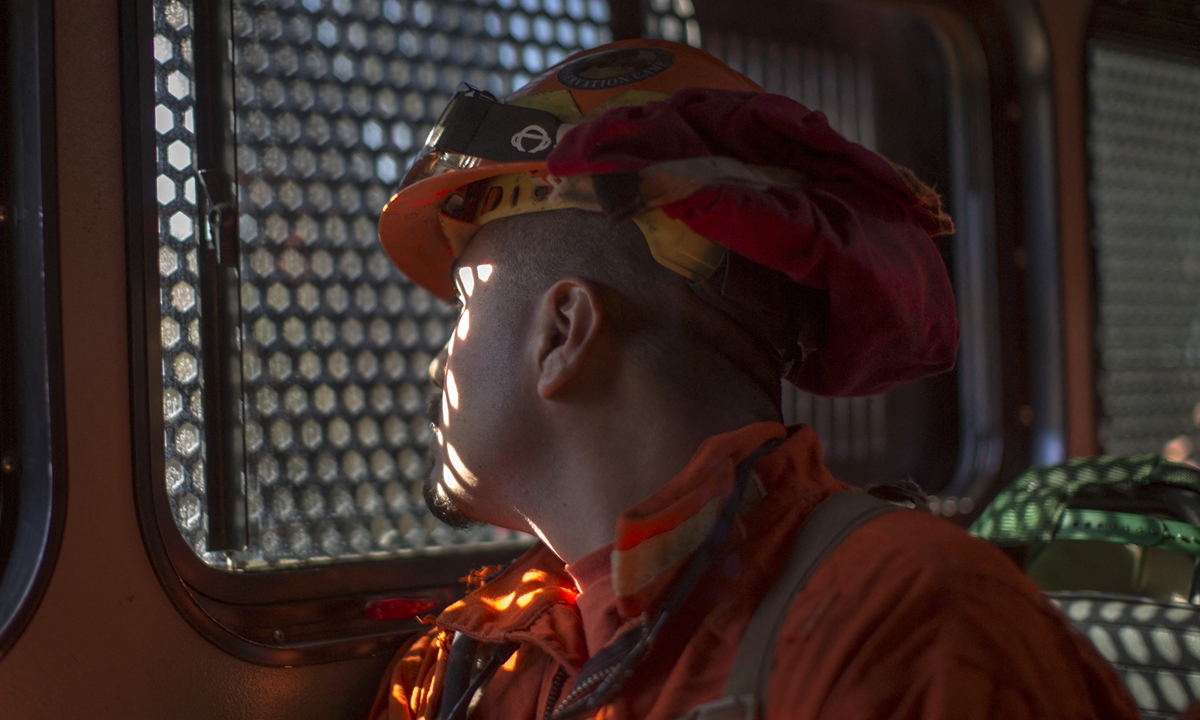
An inmate firefighter from Oak Glen Conservation Camp in California looks out at the free world as he is transported to a work assignment under the authority on September 28, 2017. Photo: AFP
The report indicated that “the use of incarcerated labor saves California taxpayers about $100 million a year.”
“The inmate crews are one of the largest assets Northern California has. Literally,” NBC news quoted Lassen County Supervisor Gary Bridges.
So in the US, when the political elites talk about human rights issues, they accuse other countries of serious human rights problems but shut their eyes when it comes to their own country’s records on human rights, which is extremely horrific, Zhu Ying, a professor of human rights law at Southwest University of Political Science and Law, told the Global Times.
“This is a double standard that the US typically uses to weaponized ‘human rights’ issues, using them as a tool and excuse to intervene in other countries’ affairs and even carry out ‘color revolutions,'” Zhu said.
Trading behind the crime
Behind the “legal slavery” system in jails, over the years, prisons in the US have colluded with black-hearted politicians to force prisoners to work for commercial interests, turning prisons into slavery-style “concentration camps” where the capitalists and politicians wantonly amass money and oppress the poor.
As a result of this collusion, private prisons were born in the 1980s and their number has been consistently growing. In 2019, there were about 116,000 prisoners held in privately operated facilities, representing about 7 percent of all state prisoners and 16 percent of federal prisoners, according to the Bureau of Justice Statistics.
At present, CoreCivic, formerly the Corrections Corporation of America, and GEO Group have become the two biggest giants in the private prison industry in the US.
When running a prison becomes a profitable business, inmates are no longer a life in the eyes of private prison companies, but a commodity and a source of income.
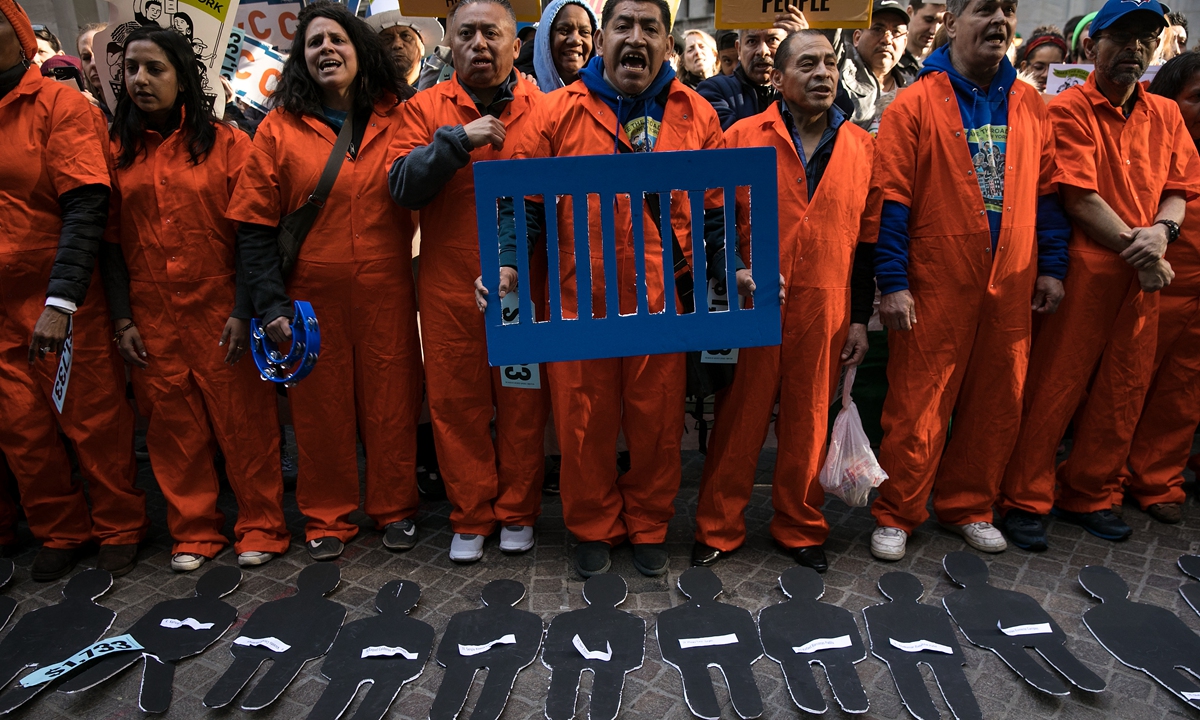
Activists rally against financial institutions’ support of private prisons and immigrant detention centers, as part of a May Day protest near Wall Street in New York City on May 1, 2018. Photo: AFP
Private prison companies in the US, under contracts with the government, receive a certain amount of money based on the number of inmates they hold on a daily basis.
According to US-based NGO RepresentUs, private prison companies employ large numbers of lobbyists in both the state and the federal government to influence lawmakers through campaign donations, to enact laws to keep private prisons at capacity at all times. For years, private prison companies have exploited America’s “corrupt political system” to achieve higher incarceration rates and profit margins.
The two largest private prison companies alone have spent $35 million on lobbying and campaign contributions to state and local officials since 1989, according to RepresentUs.
The companies have also maintained a close relationship with politicians. For instance, the GEO Group was “one of the top contributors” to the presidential campaign of Marco Rubio, who is now a senior US senator from Florida, between 2013 and 2014.
The social operation of the US relies on economic promotion and profit dominance, but when the same principle is followed by running prisons, it can only cause a great deal of tragedies, Li Haidong, a professor at the Institute of International Relations of China Foreign Affairs University said. “This not only reflects the existence of systemic human rights problems in the US, but also shows the degeneration of their social ethics and morality.”
In the US, private prisons are no longer places for punishing or reforming criminals, but places for maximizing the economic value of the detainees, and having become a “black hole” in national governance, an expert on international relations told the Global Times under the condition of anonymity.
Inmates walk in a line at San Quentin State Prison in California on August 16, 2016. Photo: VCG

